HR Innovation Explained: Impact, Trends & Best Practices
Explore HR innovation with examples, trends, challenges, and strategies to transform workforce management and drive business growth.
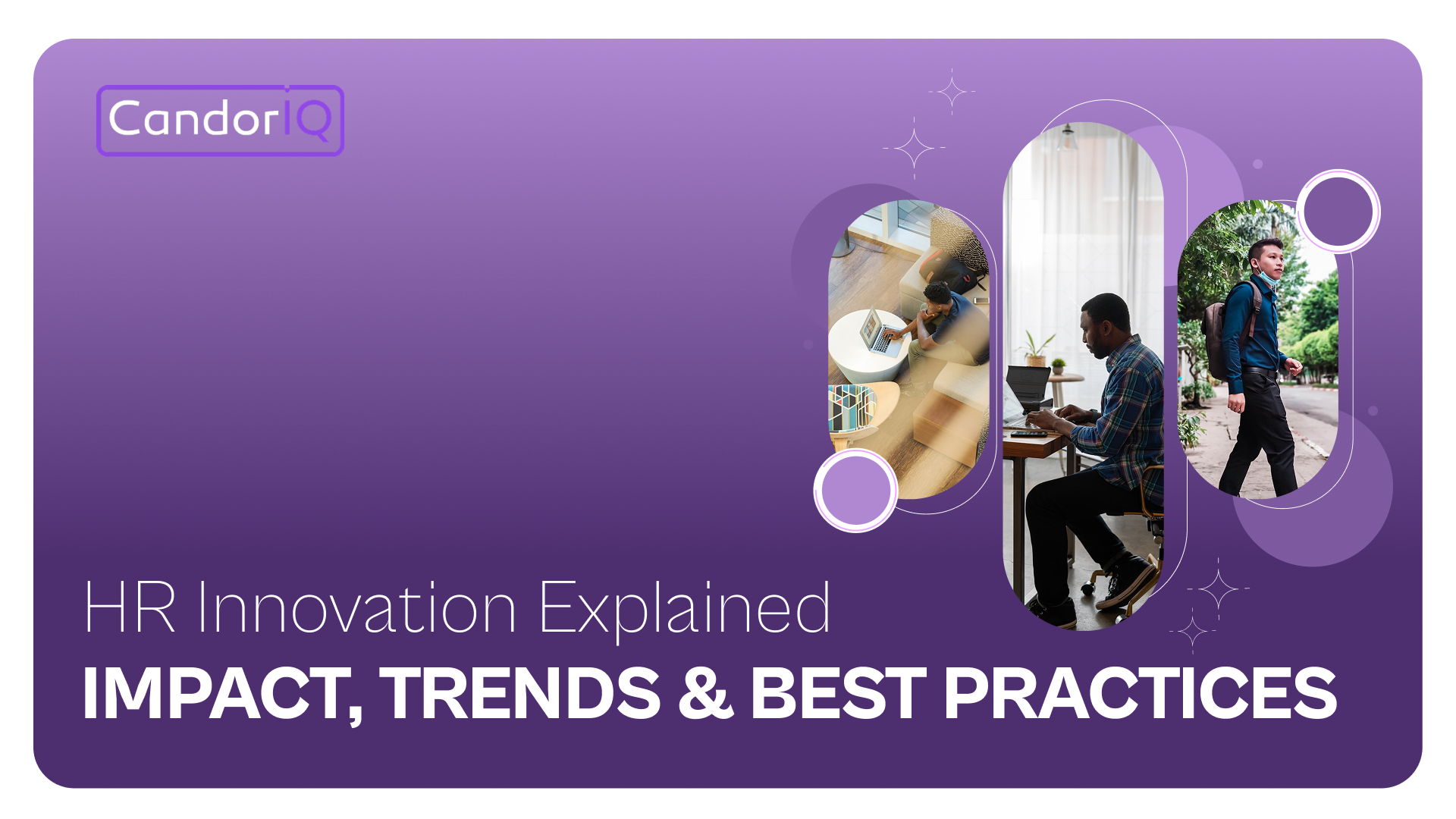
Today, HR innovation has become an absolute necessity. Workforces are now more diverse, distributed, and effective than ever, and traditional HR practices alone can’t keep up with these demands. Companies that are willing to stay competitive and attract top talent need to rethink how they engage employees, manage talent, and strengthen overall performance.
We understand how challenging it can be for HR leaders to balance evolving employee expectations with business goals, especially when traditional methods no longer deliver the results they once did.
Innovation in HR is about adopting new technologies and creating smarter, more human-centric ways of working. From AI-driven recruitment to personalized employee experiences, forward-thinking organizations are setting a new standard for the workplace.
So, how can HR leaders keep pace with this constant change? In this blog, you’ll look at the impact of HR innovation, the top trends shaping the future of work, and practical strategies your HR team can use to grow in this new era.
Key Takeaways:
- HR innovation moves beyond admin tasks by using AI, automation, and data to make HR more strategic, efficient, and people-focused.
- It creates smarter hiring, stronger retention, higher engagement, and measurable gains in efficiency, diversity, and resilience.
- In 2025, HR is shaped by AI-driven recruitment, personalized journeys, hybrid work solutions, predictive analytics, DEI dashboards, and blockchain payroll.
- Organizations drive impact through continuous learning, well-being programs, inclusive practices, and agile HR models.
- The results include faster hiring cycles, reduced bias, better retention, lower burnout, and a stronger HR role in business growth.
What is HR Innovation All About?
HR innovation involves introducing fresh ideas, technologies, and strategies into human resources to enhance work efficiency, effectiveness, and employee engagement.
Today, as the workplace evolves faster than ever, HR innovation isn’t just about keeping up; it’s about staying ahead. With advances in technology, AI, and data analytics, HR is moving beyond administrative tasks to take on a more strategic, data-driven role.
At its heart, HR innovation is about tackling familiar challenges in smarter ways. This could mean automating routine tasks, creating personalized experiences for employees, adopting more effective recruitment methods, or boosting engagement across the organization.
It’s about rethinking traditional HR practices and embracing tools and strategies that deliver better results for both the business and its people.
Why HR Innovation Matters?
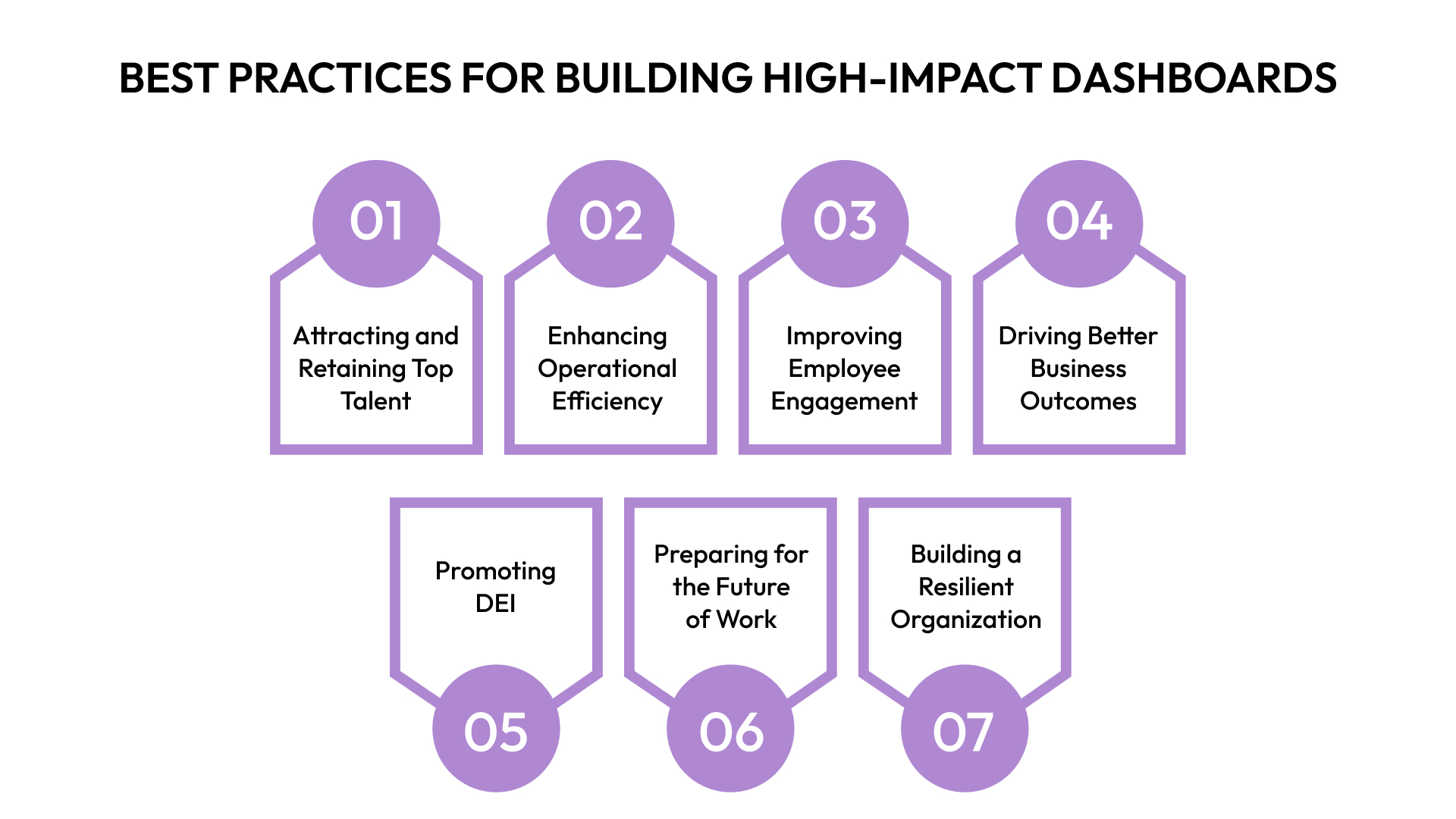
Today, HR innovation is essential. With fast-moving technological changes, shifting workforce dynamics, and rising employee expectations, forward-thinking HR strategies are critical for staying competitive.
Innovation in HR acts as a catalyst, helping organizations make the most of their workforce, enhance employee experiences, and ensure HR practices support overall business goals. Here’s why HR innovation matters now more than ever:
- Attracting and Retaining Top Talent: Innovative HR strategies help organizations stand out by offering personalized experiences for candidates and employees. HR innovation gives businesses an edge in attracting and retaining the right people.
- Enhancing Operational Efficiency: Automation, AI, and data analytics simplify onboarding, performance management, and other HR tasks. Cloud-based platforms free teams from administrative work, allowing focus on strategic priorities that drive business impact.
- Improving Employee Engagement and Experience: Employees today expect more than a paycheck; they seek meaningful experiences. Personalized journeys, real-time feedback, customized career development, and AI-driven wellness initiatives boost engagement, satisfaction, and retention.
- Driving Better Business Outcomes: When HR aligns with business goals, companies perform better. Innovative practices ensure the right people are in the right roles with the right skills, enhancing workforce planning, talent management, and overall performance.
- Promoting Diversity, Equity, and Inclusion (DEI): HR innovation helps create inclusive workplaces. AI and analytics can identify biases in recruitment, evaluations, and promotions. Fair algorithms and diverse hiring practices encourage equity, creativity, and collaboration.
- Preparing for the Future of Work: With remote work, AI, gig economies, and automation on the rise, flexible policies and effective remote team management are essential. HR innovation helps organizations adapt and prepare for future challenges.
- Building a Resilient Organization: Adaptability is key to long-term success. Innovative HR supports change management, contingency planning, and workforce engagement, ensuring employees remain motivated and capable amid disruptions.
Understanding what HR innovation means is one thing, but seeing it in action brings the concept to life.

12 Examples of Successful HR Innovation
HR innovation is reshaping how businesses manage and support their people. With competition rising across the US, companies are turning to new approaches to attract, retain, and grow talent.
From AI-powered recruitment to more personalized employee experiences, these 12 examples highlight how innovative HR practices are making a real difference for both businesses and their teams.
1. Continuous Feedback at Microsoft
Microsoft has moved away from the traditional practice of annual performance reviews and embraced a culture of continuous feedback. Through AI-powered tools, employees now receive regular, real-time input and coaching that helps them track their progress and improve as they go.
2. Personalized Learning at Accenture
Accenture has redefined employee learning by introducing an AI-driven platform that designs personalized learning paths for each employee. These paths are created based on skills, job roles, and career aspirations, ensuring that the training employees receive is both relevant and impactful.
3. Employee Well-Being at Google
Google has consistently led the way in prioritizing employee well-being. Its AI-driven wellness apps monitor mental health, stress levels, and work-life balance to provide employees with personalized recommendations and resources.
4. Smarter Hiring at LinkedIn
LinkedIn uses its own AI-powered algorithms to transform recruitment. By automating candidate sourcing and resume screening, HR teams can identify the right talent more efficiently without compromising on personalization. This innovation creates a smoother, faster recruitment process while improving the quality of hires.
5. Inclusive Hiring at SAP
SAP has integrated AI tools into its diversity and inclusion (DEI) initiatives. These tools analyze hiring patterns to prevent bias and ensure job descriptions use gender-neutral, inclusive language. The focus is on building fair, unbiased recruitment practices that strengthen diversity across the organization.
6. Automated Onboarding at IBM
IBM uses an AI-powered onboarding system that streamlines administrative work, creates personalized training schedules, and helps new hires quickly understand company culture. By automating the tedious aspects of onboarding, the system ensures a smoother and more engaging experience for employees right from the start.
7. Remote Work at Slack
Slack has become a leading example of how technology can support a remote and distributed workforce. Its cloud-based collaboration tools make it easier for employees to stay connected, share updates, and work effectively across time zones.
8. AI Learning Journeys at PepsiCo
PepsiCo has integrated AI into its learning management system to provide personalized learning recommendations. Employees receive suggestions for courses, certifications, and resources that are directly tied to their job role and long-term career aspirations.
9. Pay Equity at Cisco
Cisco uses AI to review and analyze global compensation data, ensuring that employees are paid fairly and competitively. This system allows the company to spot pay gaps and make adjustments proactively, strengthening trust between the organization and its workforce.
10. Virtual Career Coaching at SAP
SAP introduced AI-powered career coaches that provide employees with personalized career guidance. These virtual coaches help employees set goals, map out career paths, and explore opportunities for skill-building.
11. Predictive Workforce Planning at Adobe
Adobe applies predictive analytics to workforce management by identifying patterns in employee attrition, skill shortages, and future talent needs. With this data, HR leaders can make proactive, informed decisions that align business goals with workforce planning.
12. Blockchain Payroll at Bitwage
Bitwage has modernized payroll by adopting blockchain technology, particularly for international teams. Employees can receive salaries in cryptocurrency, ensuring faster, transparent, and secure cross-border payments.
These examples show how HR innovation is already reshaping the workplace. But innovation never stands still; new trends are emerging that will influence how organizations manage people in the near future.
Also Read: HR Forecasting Explained: Methods, Challenges & What’s Next
Upcoming Trends in HR Innovation
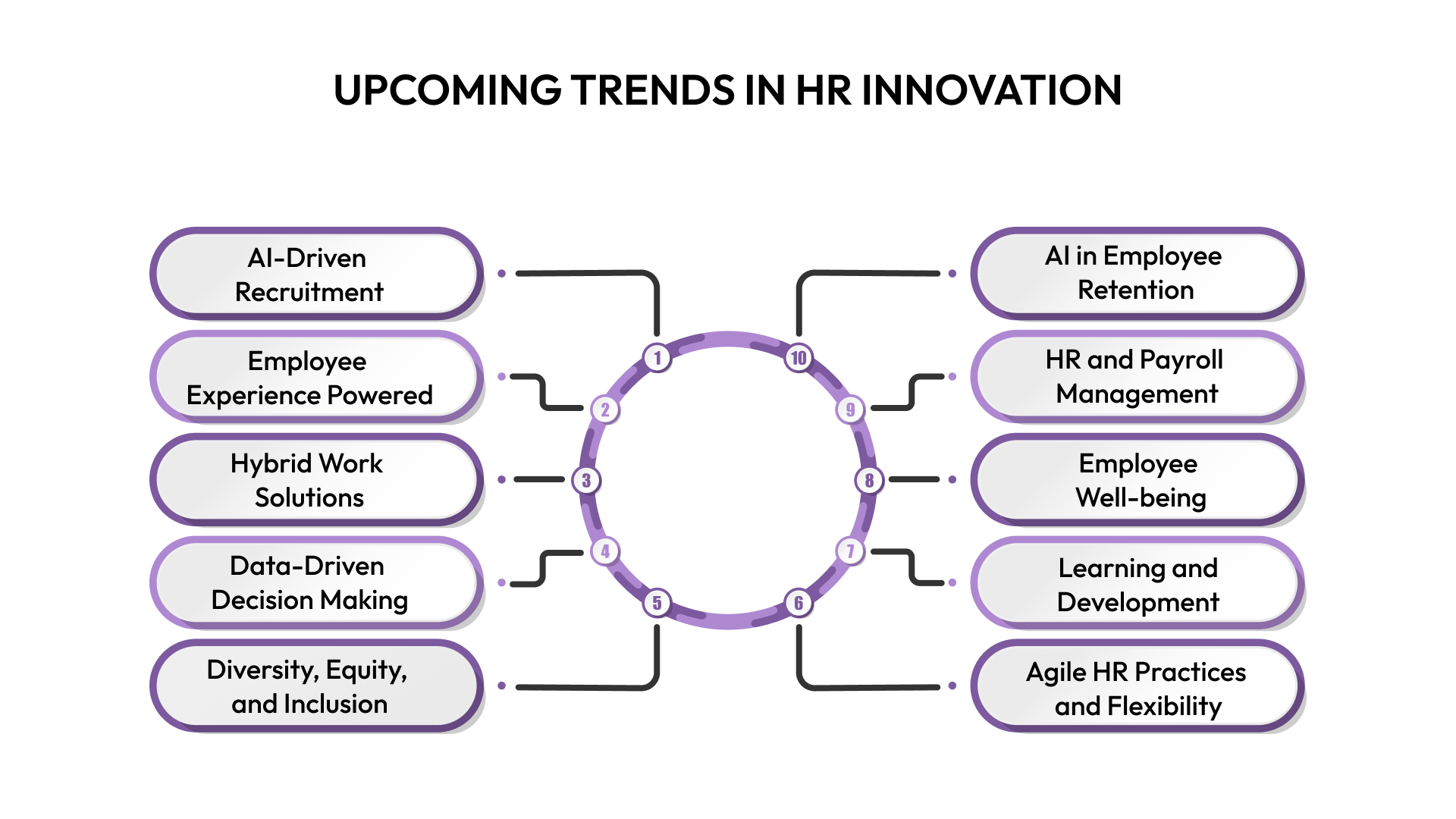
HR innovation today goes far beyond improving efficiency. It’s about rethinking how organizations attract and manage talent, keep employees engaged, and build a culture that supports long-term growth. Looking ahead to 2025 and beyond, there are many emerging trends that are set to reshape the future of workforce management.
AI-Driven Recruitment and Talent Acquisition
As competition for top talent grows, AI-powered recruitment tools are becoming smarter and more reliable. HR teams can now use AI to scan resumes, analyze skills, and even conduct video interviews. The real advantage lies in matching candidates not just to the role, but also to the company’s culture. You can expect:
- Smarter candidate matching with predictive analytics.
- Faster hiring through automated pre-screening and interview scheduling.
- Reduced bias by removing unconscious human errors in selection.
Employee Experience Powered by AI and Personalization
AI will help personalize every stage of the journey, whether it’s onboarding, learning, performance reviews, or wellness support. By tailoring experiences to individual needs, companies can keep employees more engaged and motivated. You can expect:
- Personalized learning and career development paths.
- Real-time feedback and performance tracking.
- Wellness programs that adapt to employees’ physical and mental health.
Remote and Hybrid Work Solutions
Remote and hybrid work are here to stay, and HR innovations will focus on making these setups smoother and more engaging. From collaboration platforms to virtual team-building, technology will continue to close the gap between in-office and remote employees. You can expect:
- AI-powered collaboration tools for seamless teamwork across time zones.
- Cloud-based systems for performance management and continuous feedback.
- Smarter communication tools with built-in well-being support.
Data-Driven Decision Making in HR
HR leaders are moving from gut instincts to insights. Data analytics and predictive models will help organizations make more proactive decisions about hiring, performance, and employee engagement, rather than waiting for problems to surface. You can expect:
- Predictive analytics to spot turnover risks and talent gaps.
- Deeper insights into productivity, performance, and engagement.
- Real-time workforce planning backed by data.
Diversity, Equity, and Inclusion (DEI) Innovations
Creating inclusive workplaces remains a top priority, and HR tech is evolving to support that. From recruitment to performance reviews, AI-driven tools can help reduce bias and promote fair opportunities for everyone. You can expect:
- AI-driven analysis of hiring data to ensure balanced representation.
- Bias-free performance reviews using machine learning.
- Dashboards to track and measure company-wide DEI progress.
Agile HR Practices and Flexibility
Today, agility is very important in the business space. HR teams will increasingly adopt flexible, quick-to-adapt practices that allow them to respond to both business needs and employee expectations in real time. You can expect:
- Continuous performance management with real-time feedback.
- Workforce planning tools that adapt quickly to new demands.
- Cross-functional HR teams are driving faster decisions and execution.
AI-Powered Learning and Development
Employee learning will become more personalized and data-driven. Instead of generic training, AI will suggest courses and development opportunities based on skills, preferences, and career goals, making learning more engaging and effective. You can expect:
- AI-based platforms offering tailored training paths.
- Real-time analysis of skills gaps to guide upskilling efforts.
- On-demand learning that adapts to performance and engagement.
Employee Well-being and Mental Health Tools
Well-being is no longer optional; it’s a business priority. AI-powered tools will help organizations support employees with personalized wellness resources, making it easier to address stress, burnout, and mental health challenges early on. You can expect:
- Apps that provide real-time stress management and support.
- Personalized wellness initiatives like fitness or mindfulness programs.
- Predictive analytics to identify early signs of disengagement or burnout.
Blockchain for HR and Payroll Management
Blockchain is set to transform payroll and data security by making processes faster, more transparent, and more reliable. Combined with AI, it can simplify payroll while ensuring compliance and safeguarding sensitive employee information. You can expect:
- Automated, error-free payroll powered by blockchain.
- Stronger security and privacy for employee data.
- Transparent, tamper-proof records of compensation.
AI in Employee Retention and Workforce Planning
Retaining talent is very important as hiring it. AI will help companies spot early signs of disengagement and suggest tailored strategies to keep employees motivated and satisfied, while also forecasting future workforce needs. You can expect:
- Predictive analytics to flag potential turnover risks.
- Personalized engagement strategies backed by data.
- Smarter workforce planning to prepare for talent shortages.
As these trends continue to take shape, they’re not just influencing HR practices in isolation; they’re transforming how the entire HR function operates and delivers value across the organization.
The Impact of Innovation on HR Transformation
Innovation is reshaping HR, turning it into a strategic, data-driven function at the heart of business growth. With rapid advancements in technology, automation, and AI, HR is moving beyond its traditional administrative role to become an essential part of organizational success.
From recruitment and employee engagement to performance management and talent development, the impact of innovation runs deep. Here’s a closer look at how these changes are transforming HR functions and helping organizations adapt and grow:
Enhanced Efficiency and Automation of HR Processes
Innovation is helping HR teams cut down on repetitive, time-consuming tasks. From payroll and onboarding to recruitment and performance reviews, automation and AI-powered tools are simplifying everyday operations.
This shift gives HR professionals more time to focus on meaningful work like developing talent and boosting employee engagement. It leads to:
- Significant time savings by automating routine tasks.
- Fewer errors in payroll, compliance, and other processes.
- More bandwidth for HR to contribute to strategic decisions.
Data-Driven HR Decision-Making
Gone are the days of relying only on gut instincts. With predictive analytics and machine learning, HR teams can now use real data, like performance scores, engagement surveys, and attrition trends, to make smarter decisions.
This helps organizations anticipate issues such as turnover or skills gaps before they become challenges. It leads to:
- Better forecasting of future talent needs.
- Higher retention through data-backed interventions.
- Workforce planning that’s aligned with business strategy.
Personalized Employee Experience
Employees expect the same level of personalization at work that they get from consumer apps. HR innovation makes this possible with AI platforms that create tailored career development paths, learning programs, and wellness initiatives. It leads to:
- Increased engagement and loyalty.
- Stronger retention with personalized growth opportunities.
- Improved performance through individualized learning.
Smarter Recruitment and Talent Acquisition
AI has transformed the hiring process. Instead of sifting through piles of resumes, HR can now rely on AI tools to quickly analyze skills, qualifications, and cultural fit. This speeds up hiring and ensures fairer, more accurate candidate selection. It leads to:
- Faster and more efficient hiring cycles.
- Reduced bias in screening and selection.
- Better candidate experiences through timely updates and tailored communication.
Improved Employee Well-Being and Mental Health Support
As awareness of mental health grows, HR is leveraging innovation to support employees more effectively. AI-powered wellness tools can monitor stress levels, flag burnout risks, and recommend personalized resources like mindfulness practices or wellness programs.
Companies that prioritize well-being encourage healthier, more engaged teams. It leads to:
- Lower risk of burnout and disengagement.
- Improved job satisfaction and morale.
- Stronger workplace culture centered on care and balance.
Agility and Flexibility in HR Operations
Today, agility is essential. Cloud-based HR systems enable real-time access to data, faster decision-making, and smoother collaboration across teams. Innovation helps HR remain flexible and responsive. It leads to:
- Faster adjustments to changing business needs.
- Smooth integration of remote and hybrid work models.
- More adaptable workforce planning and management.
Diversity, Equity, and Inclusion (DEI)
Building truly inclusive workplaces is now a priority, and technology is playing a big role. AI tools help reduce bias in recruitment, reviews, and promotions, while dashboards provide clear insights into diversity metrics.
These innovations allow organizations to make measurable progress in creating fairer workplaces. It leads to:
- More inclusive and diverse teams.
- Stronger employee morale and belonging.
- Better reputation as an equitable employer.
Scalable Solutions for Global Workforce Management
As companies grow across borders, managing a global workforce becomes more complex. Innovative HR platforms offer scalable, cloud-based solutions that standardize processes while still adapting to regional needs.
This ensures consistency, compliance, and collaboration across different geographies. It leads to:
- Simplified operations for global teams.
- Easier integration of remote and cross-border employees.
- Greater efficiency in managing diverse, distributed workforces.
While innovation is reshaping HR in powerful ways, it also brings its share of hurdles.

Must Read: Best HR KPI Dashboards and Examples
Challenges of HR Innovation & Ways to Tackle Them
While HR innovation opens the door to exciting opportunities, it doesn’t come without challenges. But with the right strategies, these challenges can be managed effectively. Let’s explore the key challenges HR leaders face in implementing innovation, and discuss practical solutions to tackle them.
Tackling challenges is only half the journey. For innovation to truly grow, HR teams require an environment where fresh and new ideas are encouraged and supported, and that begins with building the right culture.
How to Cultivate a Culture of Innovation in HR?
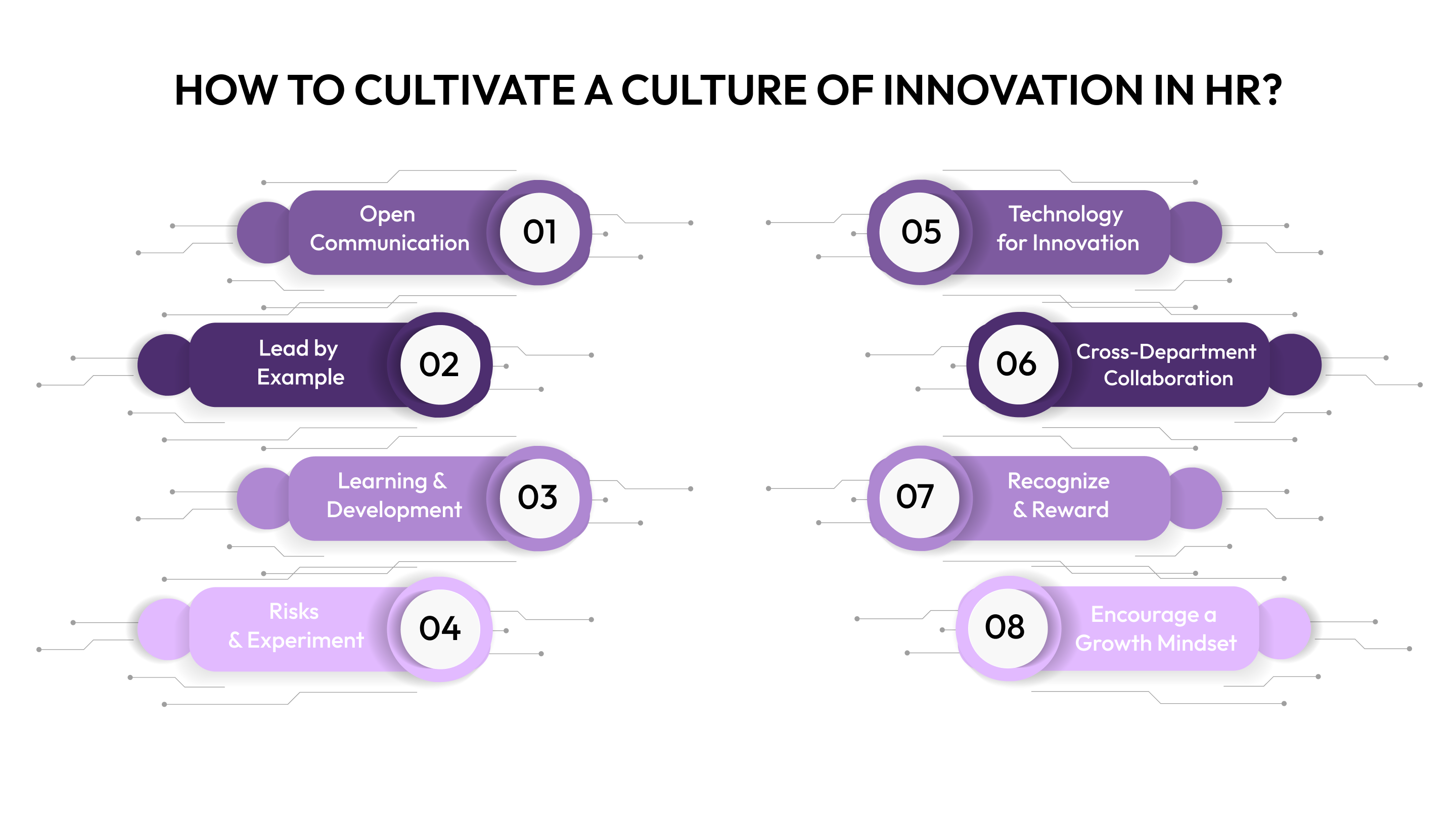
Building a culture of innovation in HR is no longer optional; it’s a necessity for organizations that want to stay competitive, keep up with workforce changes, and meet the expectations of today’s employees.
This kind of culture grows when creativity is encouraged, fresh ideas are welcomed, and people feel empowered to shape how HR evolves. Here are some practical strategies HR leaders can use to nurture and sustain a culture of innovation:
Encourage Open Communication and Idea Sharing
Innovation flourishes when people feel safe to speak up. Giving everyone a voice can spark powerful new ideas. To implement this:
- Host regular team meetings or roundtables focused on fresh HR ideas.
- Keep an open-door policy so employees can freely share suggestions.
- Use collaboration tools to gather feedback from across the organization.
Lead by Example
Change starts at the top. HR leaders who embrace new ideas, experiment with fresh approaches, and show openness to change inspire others to do the same. When leaders model innovative thinking, it sets the tone for the entire organization. To implement this:
- Test new technologies and approaches before rolling them out company-wide.
- Share examples of innovative practices from both within and outside the organization.
- Communicate a clear vision for innovation that ties back to business goals.
Invest in Learning and Development
Innovation can only grow when HR teams are equipped with the right knowledge and tools. Providing ongoing training, resources, and exposure to new trends helps HR professionals stay ahead of the curve and bring fresh thinking into their practices. To implement this:
- Offer workshops, online courses, and conferences on emerging HR trends.
- Encourage HR professionals to pursue certifications in new tools or technologies.
- Promote a culture of continuous learning, where expanding knowledge is the norm.
Empower Employees to Take Risks and Experiment
Innovation often means trying new things and sometimes failing along the way. HR should promote a culture that encourages experimentation and views mistakes as learning opportunities, rather than setbacks. To implement this:
- Recognize innovation efforts, even when they don’t succeed immediately.
- Launch pilot projects or small-scale experiments before rolling out company-wide changes.
- Reward employees who take smart risks to improve processes or solve problems.
Use Technology for Innovation
Technology is one of the strongest drivers of HR innovation. The right tools make it possible to simplify processes and personalize employee experiences. To implement this:
- Adopt AI-powered recruitment, engagement, and HR management tools.
- Regularly review new HR tech trends and explore how they fit into workflows.
- Make technology a central part of your innovation strategy to enable smarter, data-driven decisions.
Encourage Cross-Department Collaboration
Great ideas don’t come from HR alone. Collaborating with other teams, like IT, marketing, or operations, brings diverse perspectives and sparks creative solutions. Cross-functional teamwork is key to driving HR innovation that benefits the whole organization. To implement this:
- Form cross-departmental innovation teams to tackle key HR challenges.
- Involve different departments in shaping employee engagement, L&D, or talent strategies.
- Host joint workshops or innovation labs to encourage fresh thinking across teams.
Recognize and Reward Innovation
Recognition motivates people to keep innovating. Celebrating employees who bring forward creative ideas or successfully implement new HR practices encourages others to do the same. Recognition can be formal or informal, but it should be meaningful. To implement this:
- Launch innovation awards or recognition programs for creative contributions.
- Provide incentives, whether financial rewards, growth opportunities, or career advancement.
- Share success stories widely to inspire others across the organization.
Encourage a Growth Mindset
A growth mindset is at the heart of sustained innovation. When HR professionals see challenges as opportunities and believe improvement is always possible, they’re more likely to embrace change and push boundaries. To implement this:
- Train HR teams to approach challenges with adaptability and continuous improvement.
- Build an environment that embraces change and promotes problem-solving.
Creating a culture that embraces innovation sets the foundation, but what really brings it to life are the practical steps HR teams can take.
Actionable Strategies to Drive HR Innovation
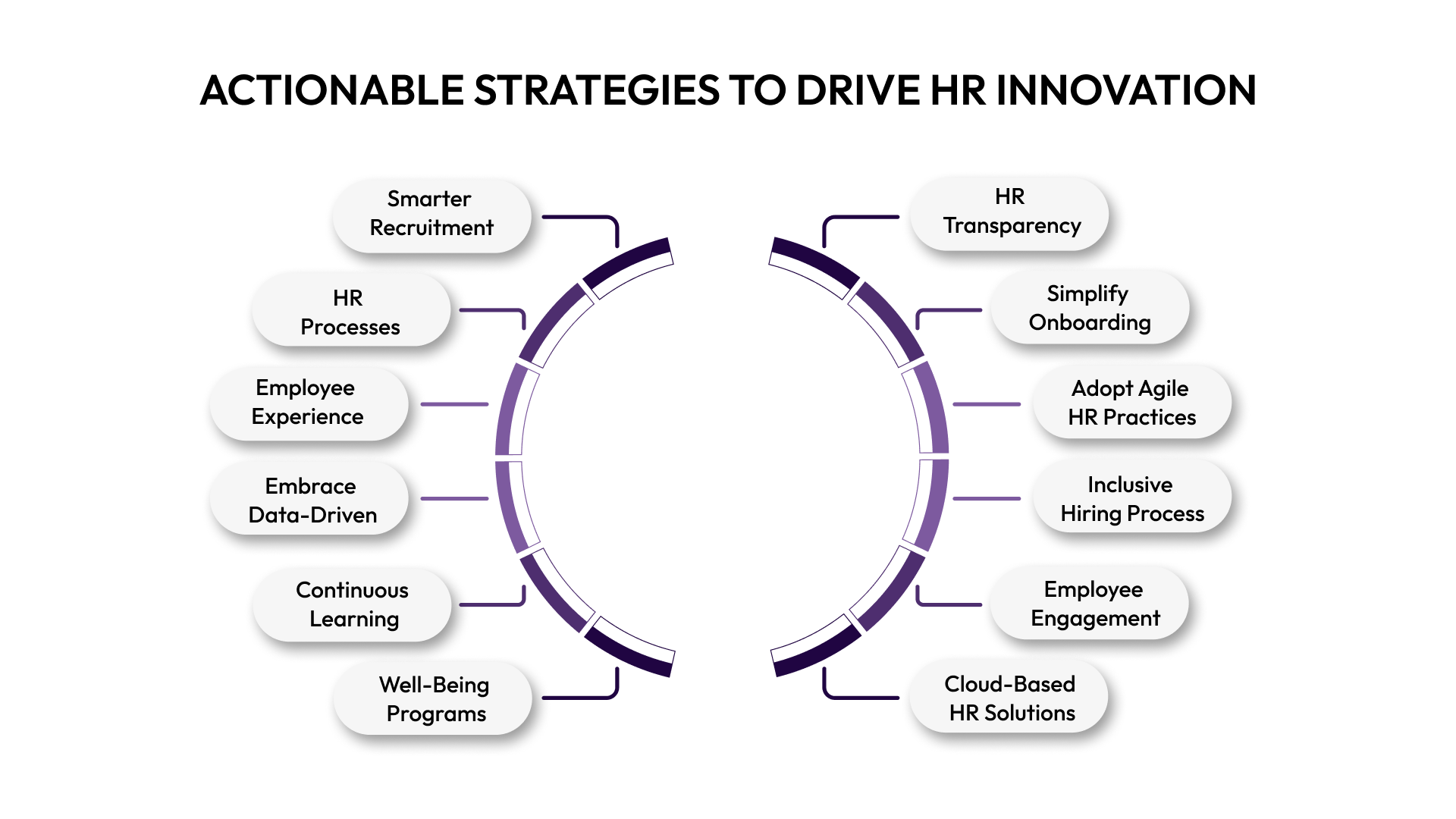
HR innovation is about building a dynamic, data-driven approach that improves employee experiences, simplifies workforce management, and ensures HR practices directly support business goals.
Here are practical strategies to help you drive HR innovation and transform your organization:
Use AI for Smarter Recruitment
AI-powered tools are transforming hiring by screening resumes, matching candidates to roles, and automating repetitive tasks. This speeds up the process, reduces bias, and improves the overall candidate experience.
Use AI-driven recruitment platforms for screening and interviews. Add chatbots to answer FAQs and keep candidates engaged during the process.
Automate Routine HR Processes
Automation takes the weight off HR teams by handling tasks like payroll, attendance, and onboarding. This efficiency allows HR to focus more on strategy and people development. Adopt platforms for payroll and benefits, and use onboarding tools to simplify workflows.
Personalize the Employee Experience
Employees grow when their growth paths feel tailored. By using data and AI, HR can deliver personalized learning, career development, and engagement initiatives that make employees feel valued.
Use AI-driven learning tools like LinkedIn Learning or Coursera. Implement engagement platforms that provide customized feedback and opportunities.
Embrace Data-Driven Decision Making
Gut instincts are being replaced with insights. Analytics help HR teams anticipate attrition, assess performance, and make smarter, proactive workforce decisions.
Use platforms to gather and analyze data. Invest in workforce analytics to track engagement, productivity, and retention trends.
Encourage a Culture of Continuous Learning
Employees want opportunities to grow. Organizations that prioritize learning see stronger engagement, innovation, and retention. So, provide them access to online learning platforms like Udemy or Pluralsight. Encourage mentorship and peer-to-peer learning.
Enhance Employee Well-Being Programs
Well-being is directly tied to productivity and retention. Innovative HR teams are adopting personalized programs and AI-driven tools to support both mental and physical health.
Introduce wellness apps like Headspace or Calm for stress management. Use AI platforms that track health data and recommend personalized wellness plans.
Use Cloud-Based HR Solutions
Cloud platforms give HR flexibility and scalability, making it easier to manage data, streamline operations, and adapt quickly to change. To implement, ensure your platform offers integration with payroll, benefits, and time-tracking systems.
Use AI for Employee Engagement and Feedback
AI tools help HR measure employee satisfaction in real time, giving leaders insights to take immediate action and improve workplace culture. Adopt engagement tools and use chatbots to open instant feedback channels between employees and HR.
Engagement and performance go hand in hand. CandorIQ supports this by linking recognition and performance outcomes in one seamless platform.
Create a More Inclusive Hiring Process
Diversity, equity, and inclusion (DEI) are essential. AI can help reduce unconscious bias and create fairer recruitment and promotion practices. Use tools to design inclusive job descriptions and interviews. Track and monitor diversity metrics with AI-driven DEI platforms.
Adopt Agile HR Practices
Agile HR enables organizations to adapt quickly, respond to employee needs, and continuously improve processes. Introduce agile frameworks in recruitment, performance management, and compensation. Build cross-functional HR teams that iterate and refine processes regularly.
Simplify Onboarding with Automation
A smooth onboarding experience sets the tone for employee success. Automation ensures consistency while making new hires feel welcomed from day one. Use platforms to automate onboarding tasks and build interactive onboarding journeys that integrate training and introductions.
Explore Blockchain for HR Transparency
Blockchain is bringing new levels of security and transparency to HR processes like payroll, contracts, and record-keeping. Use blockchain systems for payroll to ensure accuracy and trust. Utilize smart contracts for secure, tamper-proof HR documentation.
Also Read: Effective Applications of HR Analytics in Performance Optimization
Wrapping Up
HR innovation has become a game-changer for companies aiming to stay competitive in today’s talent-driven market. By adopting advanced technologies, using data-driven insights, and rethinking traditional practices, HR teams can create better employee experiences, improve performance, and build a more agile, engaged workforce.
The future of HR isn’t something to prepare for; it’s already here. Organizations that embrace these innovations today will be better positioned to attract top talent, retain their best people, and grow in a workplace that’s constantly evolving.
CandorIQ equips HR teams with advanced tools for compensation planning, employee engagement, and performance management. By combining data-driven insights with AI-powered solutions, we help organizations make smarter decisions and build strategies that truly support their people.
Ready to take your HR approach to the next level? Book a free demo with CandorIQ today and discover how our solutions can power your HR transformation.
FAQs
Q1. How can HR innovation improve employee engagement?
A1. HR innovation boosts engagement by creating more personalized employee experiences, offering continuous feedback, and designing tailored learning and development programs. With the help of technology, HR teams can better understand employee needs, track satisfaction, and address concerns proactively.
Q2. How can HR innovation improve diversity and inclusion (DEI)?
A2. Innovative HR tools play a big role in building more inclusive workplaces. AI helps reduce bias in recruitment, while analytics track diversity metrics to ensure accountability. Inclusive hiring platforms also promote fairness, making it easier to attract and retain talent from diverse backgrounds and build a truly equitable workforce.
Q3. Why is personalized employee experience important?
A3. A personalized employee experience allows HR teams to design career development plans, training opportunities, and wellness programs that meet individual needs. This boosts satisfaction and engagement and strengthens retention, as employees feel their career goals and work-life preferences are understood and supported.
Q4. How do AI and automation support HR innovation?
A4. AI and automation free HR teams from repetitive manual tasks, speed up candidate matching, and improve employee engagement through smarter insights. HR professionals get more time to focus on talent development, workforce planning, and building a stronger organizational culture.


